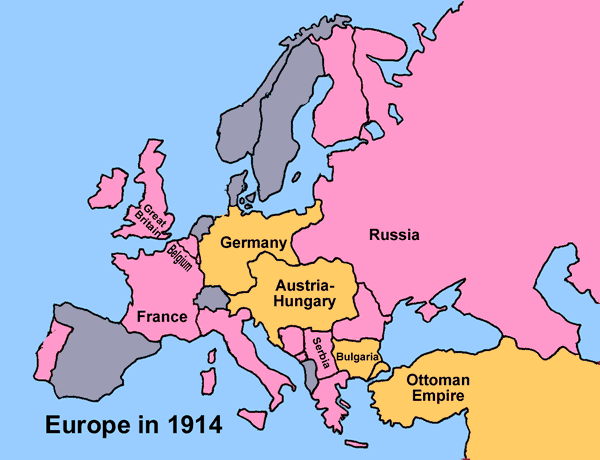Europe dissolved into many cultures at the end of the Roman Empire. Several smaller empires emerged, but none matched the power and glory of Rome. By the turn of the twentieth century, most of the smaller states of Europe combined or were conquered into larger nation-states.
Germany and Italy became unified nations in the latter part of the nineteenth century. They joined Great Britain, France, Austria-Hungary, and Russia as European world powers. These nations were filled with nationalism, or great national pride. These European nations expanded their borders by building imperial colonies in Africa and Asia. Most Europeans believed their nation was superior to every other nation, and many were willing to go to war to demonstrate their will.
Europe had been at peace for many years by the spring of 1914. There had not been a multinational war since Napoleon’s defeat 99 years earlier. Germany, France, and Russia fought minor wars that were of little consequence. Ethnic minorities chafed in Austria-Hungary, the final remnant of the Holy Roman Empire, but in 1914, it was reasonable to assume that Europe would remain at peace for many years. That assumption would turn out to be false.

Archduke_Franz_Ferdinand
Archduke Franz Ferdinand (1863 – 1914) was heir apparent to the Austro-Hungarian throne. His assassination in Sarajevo precipitated World War I.
 Europe in 1914 has often been compared to a powder keg: safe and secure until a fuse is lit. That summer, a missed turn by an unfamiliar driver led to “the Great War,” the most destructive conflict then known to humankind.
Europe in 1914 has often been compared to a powder keg: safe and secure until a fuse is lit. That summer, a missed turn by an unfamiliar driver led to “the Great War,” the most destructive conflict then known to humankind.
The city of Sarajevo is at the foot of the Balkan Mountains. Sarajevo was a city of great unrest because Austria-Hungary had seized the city and the surrounding region five years earlier. On June 28, Archduke Francis Ferdinand and his wife visited the city. Ferdinand was the heir, or next in line to be emperor of Austria-Hungary. There were rumors of an assassination attempt by ethnic Serbians in Sarajevo, but the Archduke and his wife wandered through the city believing they were safe. A group called the Black Hand proved otherwise.
The Black Hand was an ethnic Serbian terrorist organization composed mainly of teenagers. Several Black Hand members were in Sarajevo with orders to kill the Archduke. That morning, the Archduke and his wife narrowly missed death when a terrorist attempted to throw a bomb into their car. The driver sped up, causing the bomb to bounce off the Archduke’s arm and land behind the car. The following car in the procession was destroyed. Several people were injured.

Aassassination_of_Franz_Ferdinand
This illustration of Gavrilo Princip shooting Archduke Franz Ferdinand and Duchess Sophie by Achille Beltrame appeared in the Italian newspaper Domenica del Corriere.
After the Archduke gave a speech, he decided to go to the hospital to visit the people wounded in the attack. The Archduke’s driver was unfamiliar with the route and took a wrong turn. The car stopped in front of a café, where Gavrilo Princip sat sipping coffee only five feet away. Princip was a Black Hand terrorist who thought the opportunity to kill the Archduke had passed. Suddenly and by coincidence, Princip was presented with another chance. The young Serbian shot three times, killing the Archduke and the Archduke’s wife.
Gavrilo Princip set events in motion that would lead to worldwide conflict. Princip died in prison, but he was a hero to many Serbian people. The store in front of the site where the Archduke was killed became a museum that honored Princip. The museum closed in 1992 because ethnic violence made it a target of snipers. The cultural tensions that led to World War I was still a factor in the Balkan region almost eighty years later.
Resources
Download this lesson as Microsoft Word file or as an Adobe Acrobat file.
Listen as Mr. Dowling reads this lesson.
Mr. Donn has an excellent website that includes a section on World War I and World War II.

Gavrilo_Princip
Gavrilo Princip (1894 – 1918) was a nineteen year old Bosnian Serb who assassinated Archduke Franz Ferdinand of Austria and his wife, Sophie in Sarajevo in 1914. Princip was twenty-seven days too young to be executed for his crime. He died in prison three years later.




